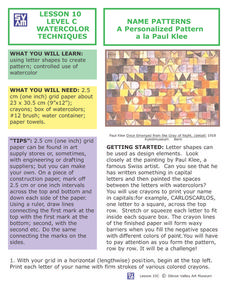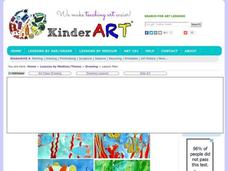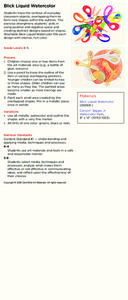Curated OER
Exploring Weather Conditions Through Painting
Your advanced class will paint a picture of a particular weather condition. In this painting lesson students describe elements of art in pieces of artwork. They analyze the weather and seasons in the artwork. The students use paper,...
J. Paul Getty Trust
Still-Life Painting: Arranging Nature—Lesson 1
Art learners examine still-life arrangement images and respond to a series of prompts. In a whole-class discussion, pupils list elements and qualities that still-life paintings can have. After instructors create an arrangement and model...
Dick Blick
Mardi-Gras Mask
Celebrate Mardi Gras in style with beautiful sparkling masks! Class members use provided materials to create their own Mardi Gras masks and then don their costumes for a fun masquerade.
Arts Ed Washington
Art Lessons in the Classroom: Our Family
Blend art and family into one lesson with an activity involving oil pastels and watercolors. After viewing a few famous portraits of families, learners create masterpieces that represent their own families.
Margaret Bearden
Painted Interiors by Andrew Wyeth
Although this 13-slide presentation focuses on lesser-known works by Andrew Wyeth viewers will still recognize his color pallette, realism, and stark images.
Willoughby-Eastlake City Schools
Watercolor Project
Lead your class into watercolor with a well-sequenced plan. Pupils learn about famous watercolorists Winslow Homer and Georgia O'Keeffe and take notes on a presentation about these artists and watercolor techniques. After a teacher...
Curated OER
Name Patterns
Here is a fun, colorful, and engaging art project that is sure to get your kids excited! They make a piece of art using watercolor paints, and by making a design out of the letters of their first name. This would be a fantasti art...
Curated OER
Under the Sea
Tropical fish are a great subject for any art project, they are colorful, interesting, and can go along with under water themed stories read in class, learner written narratives, or Marine Biology units. This set of instructions will...
Curated OER
A Bug's Life
Look at life from a bug's perspective, and create a wonderful image based on what you think it sees. Learners use the crayon resist painting technique to draw and paint and picture of a bug's world from its point of view. Tip: This would...
Curated OER
Learning to Resist: Watercolor
Consider wax resist drawings as a way to bridge art and science. Learners view, discuss, and practice drawing insects or animals using waxy crayons. They pay attention to the creature's features as they create images with watercolor and...
Curated OER
Blick Liquid Watercolor
Introduce this abstract art to your class; they must chose ordinary classroom objects and shapes to paint with watercolors. The overlapping effect will create a fun, abstract piece of art!
Curated OER
Towers and Turrets
A instructional activity on architecture will help young artists consider perspective. Your class will use water colors to paint towers and turrets. You can connect this art instructional activity to famous buildings like the Taj Majal...
Curated OER
Paper Clay Leaves
Using real leaves to imprint clay, your class will see a natural effect on their individual projects. This is a fabulous way to study leaf anatomy in science. Or, you can focus on mixing colors to recreate the original. These leaves can...
Curated OER
Koi Pond
Create this beautiful koi pond scene using watercolor paper, crayons, and paints. This would be a fantastic project to link to a scientific study of pond life or a historical study of Japanese culture.
Andrea Mulder-Slater
Happy Accidents Painting
A person can see a lot of different things when he looks at the amorphous clouds. The same is true when you let your watercolor paints do as they please. Little artists create haphazard art with watercolors, then use ink or marker to...
Curated OER
Japanese Fan
First graders learn about the traditional purpose of Japanese fans. They practice using two new brush strokes as they create nature-inspired fans, similar to those seen in Japan. A web link and basic background information is...
Curated OER
Raindrops Keep Falling on my Art
Kids may be a little resistant to this rainy day idea, but it could produce some amazing art. They paint a watercolor picture of anything they like. When they are done, they take their paintings outside and let the rain work its magic!...
Curated OER
Watercolor Rainbows
Who doesn't love a rainbow? Little ones adore them, so why not make rainbows the subject of your next art project. Your class can use watercolor to paint rainbows. As they do, have them identify the colors in the rainbow, talk about how...
Curated OER
Calico Watercolor Cats
A fun art project, this instructional activity incorporates math and listening skills as young artists play with a new painting technique. First the teacher models how to draw a cat using shapes, an oval for the body, triangles for the...
Curated OER
Emily Carr Trees
Students examine the work of artist Emily Carr. In this watercolor instructional activity, students observe how to draw trees and to use crayon resistance. Students also create a watercolor tree.
Curated OER
Watercolor Painting- Pointillism with Fruit
Fifth graders explore pointillism painting techniques. In this pointillism painting lesson plan, 5th graders paint fruit using shades and tints. Students use the pointillism techniques along with watercolors to create a layered...
Curated OER
Weaving a Watercolor
Learners examine the color wheel and work with watercolors. In this color lesson plan, students go over primary, secondary, and intermediate colors before watching a demonstration of watercolor brush techniques. They choose a shape to...
Curated OER
Properties of Water with a Splash of Color
Students explore the properties of water. In this cross curriculum art and physical science instructional activity, students experiment with a variety of materials to demonstrate the cohesive forces and adhesion of water. Students create...
Curated OER
Tansai Sumi Painting
First graders study Japanese art and apply the technique of Tansai Sumi (lightly colored) to create individual works of art. Painting, design, lines, and drawing techniques are covered in this 1st grade lesson.

























